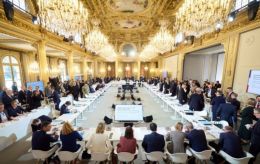Elite or undertrained soldiers? Type of North Korean troops sent to Russia, according to expert
 Photo: North Korea may have sent teenage soldiers, not elite troops, to Russia (Getty Images)
Photo: North Korea may have sent teenage soldiers, not elite troops, to Russia (Getty Images)
The involvement of North Korean military personnel in the war against Ukraine is an undeniable fact. However, the question remains as to which specific soldiers North Korea has decided to provide to Russia and whether Kim Jong Un’s "elite" special forces are among them.
Read about which DPRK troops will fight against Ukraine in the new material by RBC-Ukraine below.
What is known about North Korean military participation in the war against Ukraine
According to Ukraine’s Defense Intelligence, the first units of North Korean military personnel, trained at eastern Russian military grounds, have already arrived in the combat zone. Notably, their presence was documented in Russia’s Kursk region on October 23.
Intelligence estimates that around 12,000 North Korean soldiers have been deployed to Russia, including 500 officers and three generals from Pyongyang.
This Monday, NATO Secretary General Mark Rutte confirmed that Moscow has indeed relocated North Korean soldiers to the Kursk region, with at least 3,000 troops reportedly on site, already conducting field coordination.
Media outlets have also reported a potential first strike by Ukrainian forces on North Korean soldiers. It is speculated that artillery might have hit a building in the Kursk region where they were located, though official confirmation of this has not yet been provided.
Meanwhile, Western media and statements from Western and South Korean officials have offered various assessments of which specific units Pyongyang decided to “share” with Moscow. South Korean intelligence previously suggested that North Korea may have sent troops, potentially including special forces units.
The New York Times, citing informed sources, reported that by October 28, 5,000 soldiers from Kim Jong Un's so-called "elite" military unit are expected to be stationed in Russia's Kursk region.
In contrast, The Wall Street Journal, citing analysts, reported that these are not elite units and that they are using outdated military equipment.
"They are seemingly young — teenagers or in their early 20s — and likely in the early stages of military conscription, according to video footage and intelligence officials. The soldiers appear relatively short and slightly built, reflecting widespread malnourishment across impoverished North Korea, military analysts say," the WSJ article states.
South Korean intelligence now shares a similar view. A report from the agency, published in the media, indicates that North Korean troops in Russia mainly consist of young men under 20, with some of them being teenagers.
The report indicates that intelligence data and video recordings reveal that many soldiers are teenagers and young adults, likely in the early stages of their service. These soldiers reportedly appear relatively short and slender, suggesting issues of malnutrition in North Korea.
Which North Korean soldiers Pyongyang decided to send to Moscow
According to Oleksandr Musiienko, Head of the Сenter for Military Law Research, assessments of the quality of North Korean soldiers deployed to participate in the war against Ukraine vary because it’s currently difficult to determine how prepared these troops are until they are directly tested in combat.
"In other words, how well-prepared and motivated they are, and how they will behave in combat will only be known in battle. Everything else is speculation, analysis, and assumptions based on available media and other sources," Musiienko explained.
He also expressed hope that Ukraine will eventually have a comprehensive list and detailed information about North Korean troops, their capabilities, and strengths.
"This is because we have embarked on deeper cooperation with South Korea, as President Volodymyr Zelenskyy mentioned. Soon, a Ukrainian delegation will be formed to work in this area, so we will gain more information," he added.
Musiienko emphasized that no one is underestimating or overestimating the enemy. For now, the Ukrainian Defense Forces are preparing to repel attacks, including those involving North Korean troops.
"We view this as simply 'another enemy has appeared,' whether they are North Koreans, Buryats, Tuvans, or Dagestanis. It makes no difference. From a purely military standpoint, it’s seen as an increase in enemy forces, whether they are North Koreans or Russians. For us, this is predictable," Musiienko noted.
He added that it is evident Russia will attempt to push Ukrainian forces out of the Kursk region. The expert recalled that the enemy had already made at least two large-scale counterattack attempts, achieving partial success in these operations.
"But our forces have also managed to stabilize the situation somewhat and even regain certain lost positions. So, it’s clear that for Russia, which is conducting offensive operations and lacks a significant amount of internal reserves on its own territory — since they have all been deployed in combat — an additional 3,000 to 5,000 troops is indeed a force on which they are now relying," Musiienko concluded.
RBC-Ukraine previously reported that South Korea has not ruled out the possibility of sending its own troops to Ukraine following North Korea’s deployment of soldiers in support of Putin's army.
Additionally, a South Korean delegation is set to visit Ukraine, where it intends to meet with intelligence and defense representatives to share information on the battlefield situation and discuss cooperative measures.
Sources: information from Ukrainian and South Korean intelligence, materials from The New York Times, The Wall Street Journal, El Pais, and an exclusive comment from Oleksandr Musiienko, Head of the Сenter for Military Law Research.

